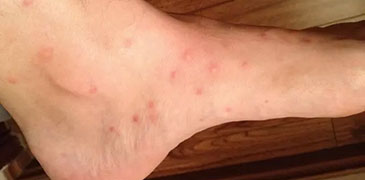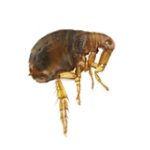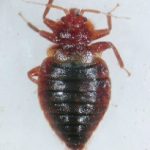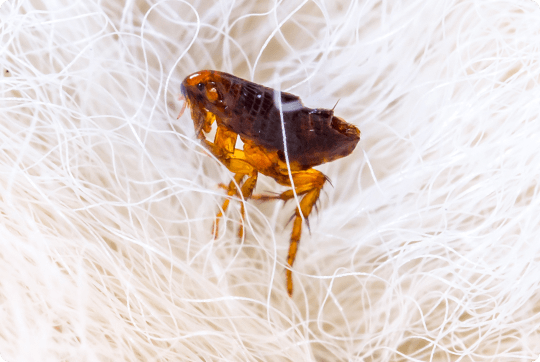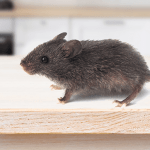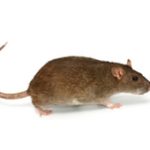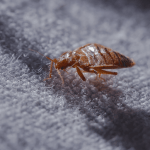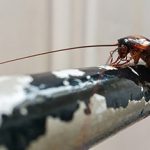Flea Eggs: What They Look Like and How to Get Rid of Them
When it comes to flea control, getting rid of the flea eggs along with the pest itself is vital in the quest of eliminating an infestation. This means that treating your pet now and again against the parasites is not always enough.
This post will explain why is that by looking into the life cycle of the vermin insects, their production of eggs and other aspects of a flea’s breeding process. You’ll also learn how to identify the eggs and where to find them around your property or on your beloved furry friend. Only this way, you’ll be able to fight the problem with success.
What do flea eggs look like to the human eye?
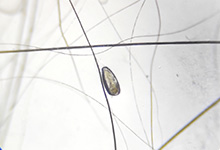 It’s quite hard to spot the flea eggs, be it on your pet, on their bedding or on the floor, due to their tiny size (less than half a millimetre long). They are oval in shape and of a whitish colour. Under a microscope, one can see that flea eggs look like rice grains. Over time, their appearance may change, in terms of colour. From shiny and almost translucent they can become bright and solid white.
It’s quite hard to spot the flea eggs, be it on your pet, on their bedding or on the floor, due to their tiny size (less than half a millimetre long). They are oval in shape and of a whitish colour. Under a microscope, one can see that flea eggs look like rice grains. Over time, their appearance may change, in terms of colour. From shiny and almost translucent they can become bright and solid white.
Image by: Morisline / License: CC BY 2.0
As we’ve mentioned, just because you know what flea eggs look like it doesn’t mean that you can easily see them on your cat or dog, especially if the animal is mostly white or of light creamy colour. So, when trying to determine the presence of eggs on your pet and inevitably, around your home, you’ll just have to assume that they are there if you’ve noticed their mums, hopping or crawling on your furry pal’s skin.
How to tell the difference between flea eggs, flea dirt, and dandruff
It’s easy to mistake flea eggs for other small particles, but identifying them correctly is key to effective treatment. Flea eggs are tiny, white, and oval-shaped—often resembling grains of rice. In contrast, flea dirt (which is flea faeces) is darker, crumbly, and made up of digested blood. You can test suspicious specks by placing them on a white paper towel and adding a drop of water—if the spot turns reddish-brown, it’s flea dirt. Pet dandruff, on the other hand, is flaky and irregular in shape, and doesn’t react to water. Understanding these differences helps target the right treatment and avoid unnecessary guesswork.
How long do flea eggs take to hatch?
A flea life cycle includes four stages and it can take anything from two weeks to several months for a flea to fully develop, depending on the environmental conditions. A flea can lay up to 40 eggs a day, as long as there is a blood source at hand. How long the flea eggs will take to hatch will again, depend on the temperature and humidity levels. In hot environments and if there’s high moisture in the air, a flea egg can hatch within as little as 2 days. The same goes for the larval and pupal stages of flea development. Those will naturally slow down in cold temperatures. On that note, flea eggs can stay dormant for months in unfavourable conditions until heat and humidity stimulate them to hatch eventually.
To sum up, the optimum conditions for a flea egg to get into its larval development stage within 48 hours are temperatures of about 30°C and over 70% humidity. In less than ideal conditions, flea eggs may take a couple of weeks to hatch.
Where do fleas lay eggs?
An adult flea, cosying up in your cat or dog’s fur and sucking on the animal’s blood, has no reason to leave its welcoming host to lay eggs. The insect will depose them right on your pet’s skin, where they will stick to it for a while. With time, however, the eggs will dry up a bit and lose the ability to stay put. They will drop on your pet’s bedding, on the carpets or in the gaps between floorboards. Even in colder months, your lovely heated home will boost their chance of survival and will provide them with the right conditions for development into adulthood. As soon as the young flea senses its potential host, it will just hop on your dog or cat to enjoy a first-time blood meal.
Check also: How do I know if my dog has fleas?
Having flea infestation in your property?
Choose professional treatment to eradicate the vermin.
How to get rid of flea eggs in your house?
As we’ve established above, treating your pet with an anti-flea product, even regularly, is often not sufficient to interfere with the insect’s life cycle. Or in other words, you may kill an existing population of fleas on your pet and still have hundreds of viable microscopic eggs ready to hatch on the floor or even on the animal itself. Yes, it sounds like an ever-ending battle, but with determination and persistence, you could eventually gain control over the situation.
So, this is what you should do if you’re not sure how to get rid of flea eggs:
- Treat your pet, first. It’s best if you treat your pet with an anti-flea shampoo, first, and use a comb to remove as many eggs and remaining fleas as possible. Then, give it a spot flea treatment and replace its flea collar with a new one for extra protection.
- Wash all bedding in the house. This applies to all fabrics, sheets, throw-overs and blankets, including your pet’s bed, of course. Even if your dog or cat, say, is not allowed in your bedroom, still sanitise your bedding just in case.
- Vacuum all surfaces. Vacuum thoroughly your home and pay special attention to corners, gaps in wood floors, baseboards and hard-to-reach places under and behind furniture. Your carpets, rugs, soft furniture and mattresses should be vacuumed more than once, too.
- Spray with an anti-flea product. Treat the surfaces in your home with an insecticidal product against pesky insects. Follow the instructions on the label and all safety measures described. If you’d rather use something organic, Diatomaceous Earth is an effective insect killer that can be used indoors in low-humidity conditions. In contact with the product, the fleas slowly dehydrate and die.
- Apply a concentrated IGR insecticidal spray. These types of products are designed to kill the eggs and the “youngins” of fleas and other pest insects, for this matter. It is also said that the main IGR ingredient affects adult fleas, as well. They become infertile and their eggs don’t hatch.
- Use essential oils as a follow-up measure. Peppermint, clover and citrus oil-based sprays also kill and repel fleas. Some people prefer natural pest control methods to chemicals, but essential oils can be also used as a follow-up preventative measure. And your place will smell nice.
What kills flea eggs instantly?
Flea eggs can be killed instantly with heat, such as washing them in hot water (above 60°C), or by using specific insecticidal sprays designed for flea eggs. Flea foggers or flea bombs may also help target eggs, though they’re not always 100% effective.
You can use a combo type of insecticidal spray that contains IGR and this way, attack the pest in all its development stages. Also, note that foggers (flea bombs) have been proven to be less effective than other forms of insecticides, even when the canister contains all the right active ingredients that kill adult fleas and their offspring. The aerosol droplets simply can’t reach all cracks and gaps around your home, hence, the product is not ideal to use for eliminating outright a flea infestation.
Conclusion
To sum up, without taking adequate measures to exterminate the fleas in all their life cycle stages of development, including the eggs, you’ll be looking at continuous flea problems and repeated infestations. Your poor cat or dog will keep getting new fleas, despite regular anti-flea care or frequent visits to the vet.
Need a professional help with the flea infestation?
Note that we only aim to provide some useful information about how to identify and get rid of flea eggs. We cannot guarantee that our suggestions will work for you.



